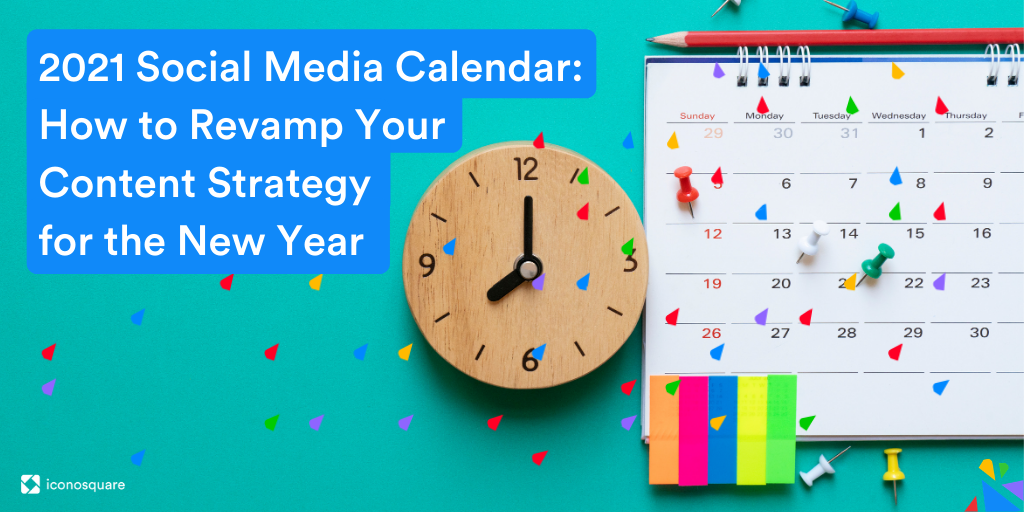2021 Social Media Calendar: How to Revamp Your Content Strategy for the New Year
The social media calendar plays a very important role in the success of your publishing strategy.
Why?
In short: social media calendars help you keep up a consistent posting schedule, centralize all your posts in one place and avoid the panic of having to write something at the last minute.
Quite useful then! 😉
Whether it’s a basic grid with a few links, or a dashboard, your calendar can be as simple or complex as your brand needs it to be. The most important is that it has to be properly built from the very beginning, otherwise it’s very easy to get lost and it can turn out to be your worst enemy.
In this article, I’ll guide you through the steps to create your own social media calendar, so keep reading!
Oh, I almost forgot! At the end you’ll be able to download Iconosquare’s 2021 social media calendar with all the upcoming holiday hashtags to get you ready for the new year.
![]()
Why do you really need a social media calendar?
These days, social networks are increasingly saturated with content, so it is becoming harder and harder for brands to differentiate themselves from the competition.
This is where the social media calendar plays a very important role. If properly implemented and followed by the team, it can dramatically improve the performance of your social media publications.
This tool has many advantages for your strategy. Here are the main things a good social media calendar will allow you to do:
Post consistently
Whatever your objectives on social media are, the first piece of advice I could give you is: be consistent!
Consistently showing up in your audience’s feed is the key to engaging them. Having a sustained and regular publication rhythm reassures your followers and places them in an environment of trust, leading them to interact often.
And there’s no better way to do that than to have a social media calendar.
A social media calendar will help you keep a steady publication flow. You wouldn’t want the last post your followers see on your Instagram account to be from 3 months ago, would you?!
Save time by planning ahead
Maintaining a social media calendar allows you to plan ahead, batch your work, avoid multitasking, stress and frustration. Basically, it’s the best way to make sure you’ll know ahead of time what you need to prepare in order to stay on schedule, so there will be no last minute, random posts.
Diversify content formats
The social media calendar will give you a global overview of your posts on social media. Thus, you will be able to diversify the formats of content you propose. You will easily be able to plan several formats of content per month like, for example, an infographic, videos, articles and news-related posts.
The advantage of having an overview and mixing up the formats you post is that you will be able to find your ideal content combo. The one that will reach more people, and get a higher engagement rate.
Don’t miss out on relevant moments
Did you celebrate Saint Patrick’s Day on social media this year? No? Don’t tell me you’ve forgotten?!
A social media calendar allows you to strategically observe global moments that are relevant to your brand’s audience. This way, you’ll never miss an opportunity to showcase your brand and boost your engagement with your community on special dates again.
Also, with your day-to-day schedule covered, if a hot topic comes up, you have the creative and logistical flexibility to take advantage of the moment and engage with your audience in an on-brand way.
Identify the highest-performing content
Finally, your social media calendar will help you easily measure the performance of your campaigns.
To do so, compare the statistics of your posts and analyze them to detect trends. After analysis, you may learn a lot about the time your posts get the most engagement on Instagram, or the type of content most liked and shared by your Facebook community – which will have a positive impact on your future social media posts.
Always rely on the results of your posts – and on your social media calendar – to optimize your content strategy and experiment new things. Using this method, you’ll soon find the perfect recipe for the best content-type, format, frequency, and the best time of day to post for each social platform.
Create your social media calendar in 6 steps
Determine your content objectives
It is essential that you clearly state your objectives for each social media channel and the content you want to publish. You will also need to be able to track what type of content is working but also what needs to be adjusted based on performance to get a better result on low-performing content.
Is your goal on Instagram to increase your brand awareness? Or are you looking to grow the size of your community? Whatever marketing objective you want to achieve, you need to clearly define it.
The objectives you define will determine your whole social media communication strategy and help you prepare your planning.
Choose your social media channels
Once you have clearly defined your objectifs, the next step is choosing the social media channel you want to communicate on. Between Instagram, Facebook, Twitter and many others, you often tend to get lost and fall into the trap of wanting to be everywhere.
As a result, many companies end up posting irrelevant content and gradually losing their followers. To avoid these mistakes, take the time to study each social media channel, list its advantages and drawbacks to establish which ones are suitable for your business.
If you are already present on some of them, I advise you to perform an audit. List out the social media channels that your company is currently active on and evaluate their effectiveness. This will allow you to analyze the performance of your current digital presence and adjust your strategy if necessary.
To do so, Iconosquare offers Instagram Audit and Facebook Audit, totally free and quick audits that give you a global analysis of your performance.
Decide what to track
Another thing you should do before starting your social media calendar is to decide the information this tool is going to provide to you. That will mostly depend on your business needs and goals, so your calendar will have to reflect them. Here are some the essential points you will need to keep track of:
- Social media platform
- Date and time of publication
- Post copy
- Visuals (e.g., images, videos, infographics, gifs, etc.)
- Link to published post
- Link to your assets
Later on, you can add more advanced details that you might potentially find helpful, such as:
- Platform-specific format (eg., feed post, IGTV, Story, poll, ads, shoppable posts, etc.)
- The topic the post is affiliated with (eg., product launch, event, contests, general brand awareness, customer service, etc.)
- Geo-targeting
- Value
- Paid or organic? (If paid, then add additional budget details)
- Has the post been approved?
- Has the post been posted? (If so, perhaps you want to include the link with its UTM)
- Analytics and results
Depending on your social media strategy complexity and KPIs, you might need to track more information. However, the above is sufficient for beginners and can still give you a good idea of how your campaign performs.
Choose your content types and topics
Before you start creating your strategy, list the themes and topics you want to cover in your communication. You can approach this step by brainstorming. This method will help you to come up with as many ideas as possible and extract a list of interesting topics. Please note that the themes and content topics should be consistent with the interests of your audience but should also reflect your brand’s image.
Let’s take the example of a fashion brand, here’s what the themes could be for a typical week:
- Monday: Publication of a blog post on new trends / fashion tips / outfit ideas, etc.
- Tuesday: Repost of user-generated content.
- Wednesday: No post.
- Thursday: Photos of the current collection.
- Friday: Publication of a commercial offer.
- Saturday: Repost of user-generated content.
- Sunday: No post.
With this first planning, the brand has already a first base to rely on in order to make sure to cover its objectives, while keeping a constant flow of content.
Determine and organize a posting schedule
Once you have an idea of the content topics and types you’re going to post, it’s time to create a posting schedule. After analyzing your past posts, you will begin to notice trends. Take a look at what days and times your old posts were posted and on which platforms.
There’s a lot of information on how often you should post on social media. To get you started, check out these 3 articles on the different best times to post on Instagram, Facebook and TikTok.
Start scheduling
Now, your social media calendar is ready!
You can start publishing your content manually, but you’ll quickly realize that it takes a loooooooot of time. Here’s my advice: scheduling is your best friend!
Scheduling all your campaigns in advance has many advantages. You’ll have more time to work on your communication strategy, analyze your previous performance or take some time to connect with your community.
At Iconosquare, we have a Scheduler for Instagram & Facebook where you can plan everything from A to Z, in a few clicks:
- Choose which post format you want to publish (Single Image, Carousel or Story for Instagram – Status, Images, Videos for Facebook)
- Upload your photos/videos from the media library that you will have built in the platform or upload from your computer.
- Add your captions and hashtags.
- Schedule the date and time you want to publish.
- View all of your scheduled posts for the week or month (or even more!).
[“source=realtyleadership”]




